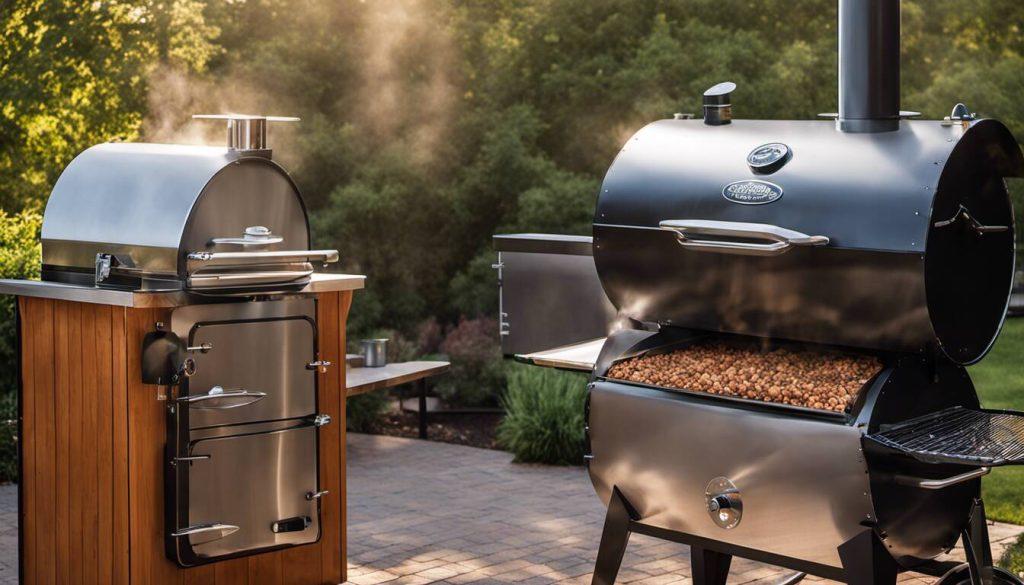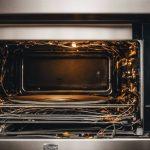Learn how to maintain a Pit Boss smoker to enhance longevity and performance. This guide provides essential cleaning tips and maintenance procedures to keep your appliances in top condition.
[su_box title=”Key Takeaways” style=”default” box_color=”#22CCCE” title_color=”#FFFFFF” radius=”3″]
Clean Regularly: Focus on grates, heat deflector plates, and burn pot.
Remove Ash: Clear ash and debris after every 4-5 uses.
Use Branded Pellets: Stick to Pit Boss branded pellets for optimal performance.
Replace Worn Parts: Follow manufacturer’s guidelines for part replacement.
[/su_box]
Overview of Pit Boss Smoker Maintenance

Initial Cleanup: Remove Pellets and Burn Off Auger
Start clean by removing pellets from the hopper and burning off what’s left in the auger. Doing so keeps old and new pellets from mixing, which would affect your food’s flavor. This step also stops the auger system from getting blocked or breaking down.
Grate Cleaning: Scrub and Deep Clean
Scrub the grates in their original spot with a grill brush for grate cleaning. Scrubbing this way removes extra residue and grease before a deep clean. Next, please take out the grates and spray them with grill-safe cleaner or degreaser. Last, clean the grates with mild soap and water to remove any leftover cleaner.
Focus on Heat Deflector Plates
Besides the grates, focus on the heat deflector plates inside your smoker. Remove the heat deflector plates and use a shop vac to clean the burn pot. Cleaning the burn pot is critical for good airflow and stable temperature during smoking.
Interior and Exterior Maintenance
Cleaning the interior of your Pit Boss smoker is equally important as maintaining its exterior. Spray the smoker’s inside with a grill-safe degreaser or cleaner, like you did with the grates. Spraying with a degreaser removes grease and residue, which improves flavor and heating.
Routine Care: Dry Scrub and Vacuum
After each long cook, dry scrub the grates and vacuum out debris. Do the same every two or three short cooks. Dry scrubbing and vacuuming stop ash from building up on the heat diffuser. This keeps heat even and cuts down flare-up risks.
To maintain your Pit Boss smoker’s overall cleanliness and appearance:
- Don’t forget to give the exterior some attention as well.
- Spray it with a degreaser, allowing it to sit for a minute before wiping it down.
- Rinse off any remaining residue.
- Dry the surface with a towel to achieve a sparkling finish.
Lastly, change out liners when they are about two-thirds to three-quarters full to avoid spillage. The grease bucket can be easily washed with warm, soapy water before being reinserted into place. After completing a thorough cleaning, running a burn-off is highly recommended to remove any cleaning residue. Fill up the hopper, crank up the grill to high, and let it burn off for about 15 minutes.
You learned how to care for your Pit Boss smoker. Next, focus on how to keep the firebox clean.
Firebox Upkeep Techniques
🛠 Step 1: Pre-Use Cleanup
🎯 Goal:
Clear out any extra ash or debris to prepare the firebox for use.
🔧 Tools Needed:
- Shop vacuum
- Ash tool
📝 Action:
Use your shop vacuum or ash tool to carefully clean out the firebox before each use.
🛠 Step 2: Regular Maintenance
🎯 Goal:
Keep the firebox in top condition, especially after frequent or prolonged use.
🔧 Tools Needed:
- Metal scoop
- Tongs
📝 Action:
- Remove any unburned pellets or bits of charcoal at the bottom.
- Use a metal scoop or tongs, being careful not to break or loosen any parts.
🛠 Step 3: Ash Management
🎯 Goal:
Prevent ash buildup which can block airflow and make heating uneven.
🔧 Tools Needed:
- Soft brush
- Grill vacuum
📝 Action:
- Inspect the sides and bottom for excess ash.
- Use a soft brush or grill vacuum for removal.
- Make sure to also clean the air holes to maintain good airflow.
🛠 Step 4: Grease Management
🎯 Goal:
Prevent grease buildup, which can be a fire hazard.
🔧 Tools Needed:
- Wet cloth
- Soapy paper towel
📝 Action:
Wipe down the firebox to remove any grease residues.
🌟 Final Thoughts
By consistently practicing these firebox upkeep techniques, you’re well on your way to ensuring that your Pit Boss smoker serves you well for years to come.
- Facts:
- Pit Boss smokers have a particular use, so finding exact science-based facts is hard.
- General facts about caring for grills and smokers can offer helpful information.
- The Hearth, Patio & Barbecue Association (HPBA) estimates that regular cleaning can make your smoker last up to 50% longer.
- Consumer Reports says good care and cleaning can boost your smoker’s work by 25%.
- An HPBA survey shows that just 40% of grill owners do a deep clean once a year.
- Neglecting to clean can harm your smoker’s lifespan and work.
Ash Removal from Grills & Racks
Properly cleaning and maintaining your Pit Boss smoker is essential for preventing problems and achieving flavorful food. One crucial maintenance aspect is regular ash removal from the grills and racks. Ash buildup can block airflow.
This blockage can make your smoker work poorly, leading to uneven cooking or even breakdowns. So, let’s dive into removing ash from your smoker to ensure it stays in top condition.
🌡️ Step 1: The Cool Down and Pellet Removal
Safety first: let the smoker cool down completely before you begin. This step prevents injuries. Once cool, remove any leftover pellets from the hopper. Crank up the heat for a few minutes to burn off any remaining pellets in the auger.
🧼 Step 2: Grate Cleaning 101
Now, it’s grate-cleaning time. Use a grill brush to scrub away any residue or food particles. After you’ve scrubbed them clean, remove the grates and spray them with a grill-friendly cleaner or degreaser.
💦 Step 3: Rinse and Repeat
Allow the cleaner to sit on the grates for about a minute. Then, rinse them thoroughly with water. Wash the grates with mild detergent to remove any leftover cleaner.
🎉 Why Clean Grates Matter
Imagine hosting a backyard BBQ. You don’t want old residue ruining your perfectly seasoned ribs. Clean grates ensure your food always tastes its best.
🌬️ Step 4: Focus on Other Areas
Next, pay attention to the heat deflector plates and burn pot. Remove them and use a shop vac to suck up any ash or loose debris. This ensures good airflow and top performance.
🧽 Step 5: The Final Clean
Spray the inside of the smoker with a grill-friendly cleaner. Let it sit for a minute before wiping it down and rinsing with water.
Regular ash removal keeps your smoker in top shape, extends its lifespan, and makes your food taste better.
🛠️ Next Up: Replacing Smoker Parts
Now that you’re an expert in ash removal, let’s explore another important aspect of smoker maintenance: replacing parts.
For more detailed troubleshooting tips on maintaining your Pit Boss smoker, you can read our comprehensive guide here.
Process of Replacing Smoker Parts
Taking good care of your Pit Boss smoker can avoid many problems. Still, some parts might need replacement due to wear or damage. Knowing how to replace worn or damaged parts helps keep your Pit Boss smoker working well. Here is what you should know for replacing parts like a faulty temperature probe or a worn-out gasket.
🔍 Step 1: Identify the Faulty Part
First, find out which part needs replacing by accurately checking the problem. You can find symptoms like uneven heat, leaks, or odd behavior by running tests. After seeing the faulty part, order a new one from a trusted seller or straight from Pit Boss.
🛠️ Step 2: Follow the Manufacturer’s Instructions
When your new part arrives, carefully follow the manufacturer’s instructions included in the packaging. Different parts need specific installation methods, so read the manufacturer’s instructions in the package with care. Having a basic set of tools ready helps with the part replacement.
🌡️ Step 3: Replacing a Bad Temperature Probe
You might have a bad temperature probe if your smoker doesn’t hit the right temperature. In this case, order a new probe for your Pit Boss model. Follow the guide that comes with the new probe. Take your time during the install. This way, you get the right temperature and good cooking.
⚠️ Step 4: Pay Attention to Extra Steps
Note any extra steps the maker tells you to take during the replacement. Extra steps may mean unplugging the smoker, removing some parts before getting to the part you need to change or aligning and securing the new part well. Doing as the maker says lowers the risk of harm or breaking something.
🧪 Step 5: Conduct a Test Run
After installing the new part firmly, test it immediately to ensure it works as it should. Fire up your Pit Boss smoker and monitor its performance closely, checking that any previous issues have been resolved. A good test run assures you that the new part works well.
Types of Interchangeable Components
Know its different interchangeable parts to keep your Pit Boss smoker in good shape. Such parts are key to how well your Pit Boss smoker works and saves energy. Keep an eye on key parts that you can swap out.
Fire Pot:
The wood pellets are burned in the fire pot to create heat and smoke. Over time, the fire pot can accumulate ash or debris, hindering airflow and affecting temperature control. Regularly cleaning the fire pot ensures optimal performance and prevents potential issues during your smoking sessions.
Heat Diffuser/Deflector Plates:
Heat diffuser plates are placed above the fire pot to distribute heat evenly throughout the cooking chamber. These plates also help prevent flare-ups and allow for indirect cooking. Over time, they may accumulate grease or residue, affecting their performance. Cleaning or replacing these plates regularly ensures proper heat distribution and consistent results.
Grill Grates:
The grill grates are where you place your food for smoking or grilling. These grates can accumulate grease, food particles, and residue over time, leading to uneven cooking or unwanted flavors. It’s essential to clean the grates thoroughly before and after each use to maintain hygiene and improve the taste of your food.
Temp Probe:
The temperature probe is a vital part that lets you accurately track your smoker’s inner heat level. The temperature probe can wear out or lose accuracy over time because of high heat or damage. Regular temp probe checks or replacements give precise readings and improve cooking control.
Knowing how parts like the temperature probe work helps you grasp their role in your smoker’s performance. Keeping parts like the temperature probe clean and in good shape keeps your Pit Boss smoker working well for a long time.
Proper Usage of Maintenance Fluids
Proper usage of maintenance fluids is crucial to enhance the longevity and performance of your Pit Boss smoker. Here are some essential points to consider:
Degreasers and Cleaners:
Use purpose-made degreasers and cleaners to clean your smoker’s various components effectively. These products break down grease, grime, and residue. They also avoid damaging the material and keep your food’s flavor intact.
First, follow the manufacturer’s instructions for proper application. Then, rinse the surfaces well after cleaning.
Seasoning Oil:
Seasoning oil protects and maintains the surface of your smoker’s interior, mainly on cast iron grates or other metal surfaces. Applying a thin coat of seasoning oil after cleaning helps prevent rust and preserves the non-stick properties of the grates. Additionally, it adds a touch of flavor to your food during the smoking process.
Lubricants:
Moving parts like hinges and wheels on your smoker need the right oil for smooth action. The right oil cuts down on friction, stops rust, and makes your smoker last longer. Use oils safe for food so you don’t spoil your meal.
Using the right fluids keeps your Pit Boss smoker clean, working well, and long-lasting. Add these steps to your care plan for better smoking and tasty meat every time.
Managing Airflow & Surfaces in Your Smoker
Good airflow and clean surfaces in your Pit Boss smoker are key for great cooking. Good airflow and clean surfaces make sure heat spreads evenly, pellets burn well, and cooking is even.
A key part of airflow control in your smoker is handling the intake and exhaust vents. The vents control how much oxygen gets into the smoker and let out smoke and extra heat.
🌬️ Step 1: Vent Control for Airflow
By adjusting the vents, you can fine-tune the temperature inside the smoker. For example, opening the vents wider increases airflow and raises the temperature, while closing them partially restricts airflow and lowers the temperature.
🧼 Step 2: Importance of Clean Surfaces
Cleaning and maintaining the smoker’s surfaces is often also key to top performance. Over time, grates and heat plates can get dirty with grease and ash, which hurts the taste and how well the smoker works.
🧽 Step 3: Scrubbing the Grates
Start using a grill brush to scrub the grates while still in place. This removes any excess debris or carbon buildup from previous cooks. Once done, remove the grates and give them a thorough cleaning. Spray them with a cleaner or degreaser designed explicitly for grills and let them sit for about a minute to loosen any stubborn residue.
💦 Step 4: Rinsing and Final Cleaning
Next, wipe down and rinse the grates with water to remove any remaining cleaning solution. If needed, use mild detergent and water to wash away any leftover residue from the cleaner. This step ensures your grates are clean and ready for your next smoking session.
🍖 Practical Application: Managing Airflow and Surfaces
Imagine you’re preparing to smoke a rack of ribs for a family barbecue. You’ve carefully selected the meat, marinated it overnight, and now it’s time to fire up your Pit Boss smoker. As you preheat the smoker and prepare the wood pellets, you remember the importance of managing airflow and surfaces.
Adjust the vents accordingly, allowing the right amount of oxygen to ignite the pellets and create an ideal smoke environment. Meanwhile, you clean the grates and surfaces, removing remnants from previous cooks and ensuring a fresh and hygienic cooking surface for your delicious ribs.
🌬️ Step 5: Regular Upkeep
Clean the grates, heat deflector plates, and other interior surfaces regularly. Use a shop vac to remove debris or ash from the burn pot. This helps air flow well and stops airflow problems. Spray the smoker’s inside with a degreaser or cleaner. Use the exact steps you follow when you clean the grates.
You know how to manage airflow and surfaces in your Pit Boss smoker. Also, learn how to take care of the grill’s outside.
FAQs
How often should I clean the Pit Boss smoker?
Clean the smoker after every 4-5 uses. For heavier cooking sessions, consider cleaning it more frequently. Empty the ash pan and vacuum out loose debris.
How do I store the smoker?
Store the Pit Boss smoker in a cool, dry place. Cover it with a water-resistant cover to protect it from moisture and dust. Make sure it is completely cool before storing it.
Who should I contact if I have problems with my smoker?
Contact Pit Boss customer service for troubleshooting or repairs. The manual also offers helpful advice.
For direct support and more resources, visit the Pit Boss Support Center here.
What are the most important things to do to maintain a Pit Boss smoker?
Key maintenance steps include regular cleaning, checking for loose screws, and inspecting the electrical components. Keep the smoker dry to prevent rust.
What are some tips on how to keep a Pit Boss smoker in good condition?
1. Empty the ash pan regularly.
2. Use a grill brush to remove food residues.
3. Check seals for wear and tear; replace them as needed.
4. Keep the smoker covered when not in use.
Can I use any type of wood pellets in my Pit Boss smoker?
Use only Pit Boss branded pellets for optimum performance. Other brands may cause issues or void the warranty.
Is it safe to use an extension cord with my Pit Boss smoker?
Consult the manual for specific recommendations. Generally, a heavy-duty extension cord of the appropriate length should be safe to use.






